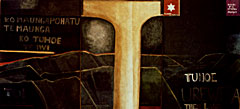John Scott 1924 - 1992
Biography
Scott, John Colin 1924 - 1992
I remember John Scott sitting on the patio at my parents’ old house (he seemed reluctant to come inside) talking about aesthetics. It was the first time I had heard the word. He called the toilet, the bog (I remember because I was twelve at the time). He sketched out his ideas on the back of envelopes and scraps of paper (we still have them).
Scott didn't like pretence. His buildings are honest and straightforward. The details are simple and functional. He let his materials speak for themselves. He arrived on the job in shorts and bare feet. He took his work seriously but not himself.
The many stories about John Scott have morphed into myths, stories of his slowness to produce drawings if clients didn't come to the design party, of his poor money management and lack of business sense.
It is hard to reconcile the stories with the quality of his architecture. I know from his buildings that he believed strongly in his work. He knew somewhere inside that the buildings would outlast the clients. He didn't sell his soul. He liked his coffee strong. He died after heart surgery, in July 1992, aged 68.
John Colin Scott was born at Haumoana, Hawkes Bay, on 9 June, 1924, the third of seven children. His parents both had Maori ancestry (Taranaki, Te Arawa). He attended Haumoana School and then St. John’s College in Hastings where he was head prefect. He joined the air force and learnt to fly towards the end of the Second World War.
He went to the Auckland School of Architecture from 1946 to 1949 and part time in 1950 but didn't graduate. He married Joan Moffatt in July 1951. He worked for Structural Developments for 18 months and briefly for Group Architects before returning to Haumoana and setting out on his own. He worked with Len Hoogerburg in offices in Hastings in the 1960s and early 1970s and later from home at the Grange. (Hoogerburg’s St. James’ Church in Hastings is worth a look. It won a NZIA merit award 1964.)
Scott's early work is domestic and influenced by Vernon Brown and Group Architects. The chapel he designed for St. John’s College in 1954 led to the commission for the Chapel of Futuna in Karori. Most of Scott's commissions were for private houses but with significant public buildings along the way, including several Catholic churches and schools, the Maori Battalion Memorial Centre in Palmerston North, the Urewera National Park headquarters and others.
The Urewera National Park headquarters at Aniwaniwa, beside Lake Waikaremoana, is an excellent example of Scott's work. It nestles into the bush, it is simple and functional, and it’s perfectly proportioned. It also contains a wonderful Colin McCahon painting which seems like an extra window, looking out on the spirit of the Urewera.

The Chapel of Futuna is regarded as Scott's best building but perhaps it is just the best known. It is significant because it is bold; it is a departure from the architecture of the time, which still looked to a European heritage. Scott was able to take New Zealand forms and develop a New Zealand vernacular. (Not that many listened. New Zealand remains largely an architectural desert, with buildings referenced to places other than our own.) The Chapel of Futuna won a New Zealand Institute of Architects gold medal award in 1968 and a 25 Year Award in 1986. Scott was awarded a NZIA silver medal for a 'House for Orchardist' in Havelock North in 1969. The Ngamatea house, built for Margaret Apatu, won a NZIA National Award in 1991. Scott was awarded a gold medal posthumously in 1999 for his contribution to New Zealand architecture. Many of Scott's other buildings deserve recognition, from Our Lady of Lourdes to the Urewera National Park headquarters, along with numerous houses throughout Hawkes Bay.
People who own his houses are fiercely loyal (with a few gripes: small kitchens, lack of lights and power points, occasional leaks) and several have commissioned a second house or bach. Living in a Scott house was described by John Pattison, who built two Scott houses, as living in a work of art. There can be no higher praise for an architect.
Craig Martin
June 2003
References:
Scott, J. & M. Ching-Fan. ‘Of woolsheds, houses and people’. Islands 2, No 3 (Spring 1973): pp 289–302
Walden, Russell. Voices of Silence: New Zealand’s Chapel of Futuna. Wellington, 1987
Walden, Russell. 'Scott, John Colin 1924 - 1992'. Dictionary of New Zealand Biography.
Shanahan, M. 'John Scott Architect of the Land'. Architecture New Zealand March/April 1988: pp 44 - 48.
Bartle V. 'Spotlight on a Modern Architectural Landmark'. Heritage New Zealand, Summer 2002: pp 26 -27.
Stewart K. Reynolds P. 'John Scott's Heritage'. NZ House & Garden Nos 13, 14, 15: September, October, November, 1995.
Haarhoff E. 'NZIA Awards List'. University of Auckland Architecture Archive. July 2001.
